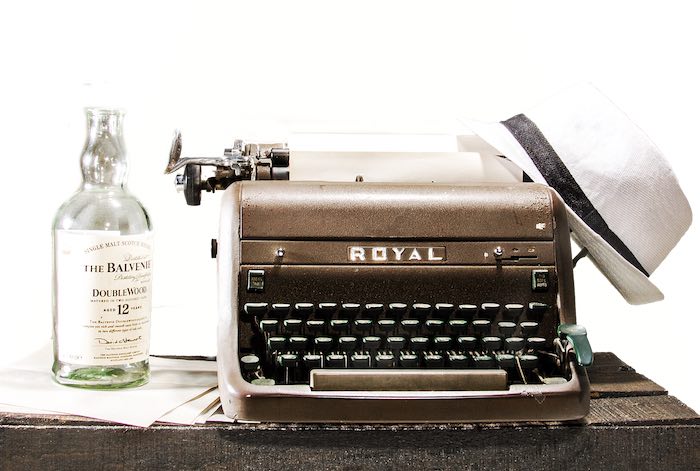Beginning and Ending Your Story
Elinor Glyn, in the early half of the 20th century, considered the "world's greatest writer of love stories." Over the course of her writing career she published 31 novels and had 9 movies made from her work. She was criticized rather frequently by the literary press, as are many popular writers today. In 1922, The Author's Press put out a four volume course written by Glyn on how to write novels, stories and screen plays. This is an excerpt from the second volume.

Why Stories Are Judged by Their Beginning.
Many are the stories upon whose merit a searching ray of illumination can be thrown by the manner in which they are begun, just as we may judge people by the way in which they respond to an introduction. If a woman, when a man is presented to her, does her best to make the other easy in a company of strangers, we may reasonably guess she is kind and thoughtful, while for the effeminate, young, sporty chap who bows in the most approved manner, his face fixed in a meaningless smile, we have only feelings of dislike. We know the latter's manner is merely form and that his politeness is for politeness's sake alone; his greeting is superficial and, for that reason, unimpressive. The person to whom he is introduced very likely will not be greatly pleased to renew the acquaintance.
So it is with stories. It has been noted that many young writers begin their work in a halting, constrained, awkward fashion. This comes from too little practice in writing. It is like riding a bicycle for the first time in a number of years; our balance is rather precarious, our muscles are not flexible.
Striking the Dominant Tone at the Start.
It usually is necessary for the amateur to proceed several paragraphs before he strikes a certain tone, then maintains it throughout. To obviate this serious defect, the young author should have decided beforehand just where to commence his narrative. Remember that the beginning is your initial bow to the public, your first strike for fame, and unless you seizethe attention right from the start, you will have failed before you fully realize why.
Do Not Keep the Reader Waiting.
A story may be begun expositorily—by giving the main traits of the chief character or. characters—by description of place, person or persons, by narrative of action, and by dialogue. Of these methods the purely expository is rather old-fashioned and ineffective. It may, admittedly, be interspersed properly with the other methods of beginning: thus the first paragraph may be a judicious mixture of vitally needed description, narrative, and exposition.
Yet, the method of introducing a story in the purely expository manner, especially if it be rather lengthy, is to be avoided. The dominant traits of a certain character will be brought out in the action or dialogue of the story, so why bother to tell about them beforehand?
Making a Strong Beginning
First impressions are invariably the strongest; consequently, it is up to the tyro to use every method of art at his employment to begin the story attractively. The reader is by no means obliged to read any story—is seduced, so to speak, into doing so; and, unless he can sense an entertaining half-hour within the first two or three paragraphs, then it is all over with the author.
Starting Off With a Strong Situation.
Besides being interesting, compressed, forceful, and suggestive, the introduction must be very much to the point. To come to the heart of matters at once is not so difficult by the use of suggestive action or language. A character may speak two or three lines, which, together with the author's comments, may reveal trait, tendency, purpose, and past existence.
Many writers have seized upon the method of beginning the story in a manner characteristic of the story's mood. This is a very wise and effective device if the opening situation only can be made attractive enough. As usual, Poe opens his story, "A Descent into the Maelstrom," in a manner prophetic of the manifestation of his theme. The manner of the beginning, too, is interesting—our curiosity is aroused—we are impatient to be on with the tale, for the old man's suggestive words of what happened to him leads the reader to believe that he has a bewitching story of the "horror" type to peruse.
"'Not long ago,' said he at length, 'and I could have guided you on this route as well as the youngest of my sons; but, about three years past, there happened to me an event such as never happened to mortal man—or at least such as no man ever survived to tell of—and the six hours of deadly terror which I then endured have broken me up body and soul. You suppose me a very old man—but I am not. It took less than a single day to change these hairs from black to white, to weaken my limbs, and to unstring my nerves, so that I tremble at the least exertion, and am frightened at a shadow. Do you know I can scarcely look over this little cliff without getting giddy?' "
Beginning Character Stories.
If the story is one of character and is written with a strict adherence to the principles of unity of impression, it will start off with a brief sketch of the main character in some revealing posture. If the tale is one of adventure, at its inception we will perceive the hero about to be involved in some perilous complication, while, if the story is one of setting, the effect of environment on the characters may have a predominant place in the introduction. It is not absolutely essential, of course, that a story of action be opened in characteristic action; it may be started off with a brief character sketch, or description, or some other device.
Beginning With Dialogue.
An excellent method of starting the story is by lively dialogue, in which, through the course of several paragraphs of conversation, we learn of the relations of some of the characters to each other. The following dialogue opens Miss Deland's story, "Many Waters." We learn in a few words the relation of the two men and the attitude both take to the initial complication brought out:
"True bill; I'm awfully sorry."
Thomas Fleming took his cigar out of his mouth and contemplated the lighted end. He did not speak. The other man, his lawyer,' who had brought him the unwelcome news, began to make the best of it.
"Of course, it's an annoyance; but------"
"Well, yes. It's an annoyance," Fleming said, dryly.
Bates chuckled. "It strikes me, Tom, considering the difference between this and the real thing, that 'annoyance' is just the right word to use."
Fleming leaned over and knocked off the ashes into his waste basket. He was silent.
"As for Hammond, he won't have a leg to stand on. I don't know what Ellis and Grew meant by letting him take the case before the Grand Jury. He won't have a leg to stand on!"
"Give me a light, will you, Bates? This cigar has gone out again."
Do Not Allow Interest to Lag.
Concerning beginning a story with lively dialogue, a warning must here be sounded. The good story is a ladder, an ascension to the supreme enunciation of the theme. Every act must bring greater complication, more intense interest. Woe betide the author, then, who allows himself to backslide even slightly in the onward march of his story toward its culmination. The amateur may think it clever to start off with catchy, spirited dialogue, expecting thereby to chain the reader's attention to his story. Feeling assured that the show of fireworks at the beginning of his story will insure an attentive audience thence on to the end of the script, he proceeds to explain just what brought the hero or the heroine in such an engaging circumstance. He may even digress so far as to describe the characters, to give all the antecedents, omitting not a single one, that preceded the initial incident.
But the modern reader is wary. He will not need to go very far before he will have sniffed a trap to inveigle him into finishing the story. Sad to relate, the trap rarely works. The reader is only human after all. He dislikes to have his curiosity piqued, then to be plunged into tiring description, exposition, and narration.
How to Dispose of Explanations Interestingly.
The writer must, above all else, follow the upward sequence of interest. After the reader's interest has been aroused, it must not be shattered by spiritless detail. Either the necessary explanations must come prior to the dialogue and the initial crisis, or the conversation must be self-explanatory of what the occasion is, together with the relation of the characters.
This latter is an excellent device. The personages meet, discuss problems paramount to their interests, and, by their talk, disclose their intentions, something of their past life, the circumstances leading up to the story, give a hint of the theme itself, and gradually sift in the important details which otherwise would have to be explained by the author himself. The following, from Henry James Froman's "A Doctor of Cheerfulness," is an excellent example of suggestive dialogue:
Even though she was pronouncing his doom, he adored her balance of emotion and reasonableness, and, secretly, he felt proud that her emotion was on his account.
"Wait one moment, Rosalind." And with a tense nervous movement he laid a protecting hand upon her arm. "Just what is it exactly that is the matter with me? Say the word and I'll change it right now!"
"When you do change it, Teddy dear, I'll marry you"; and she wiped the tears from her eyes. "But I'm afraid you can't do it in a moment, and I can't do it for you. I have heard of men being cured of all kinds of habits," she continued more quietly, turning to the fire; "drinking, smoking, drugs—anything except everlasting gloom and nervous irritation. That must take time, and a man has to do it for himself."
Here in a few words we perceive the relation of the man and the woman who speak, their present mood, the nature of each, and the theme suggested. We know the two are in love, have been some time; that the girl is loving, sympathetic, wise in her lover's moods. We find the man in despair, his dominant mood, and we receive a brief view of his nature, gloomy and irritable, as the girl herself tells him. The story may now proceed more actively; we may then learn in what fashion the man changed his nature. The title, "A Doctor of Cheerfulness," suggests that the girl herself will prove to be the medium of his metamorphosis.
A Combination Method
But, as has already been said, a number of story openings are a combination of exposition, description, and narration. The hero may be introduced in the first paragraph or two in attitude characteristic or otherwise. A brief description of his physical condition may follow, then the author may give a few of the hero's most interesting traits and accomplishments, ending with pure narrative, made up in large of the hero's actions leading up to the first complication of the story. The following, from Stevenson's "The Sire de Maletroit's Door," is an excellent example of this manner of beginning a story. The story is one of adventure and the opening is in mood with the theme.
It was September, 1429; the weather had fallen sharp; a flighty piping wind, laden with showers, beat about the township; and the dead leaves ran riot along the streets.
Here and there a window was already lighted up; and the noise of men-at-arms, making merry over supper within, came forth in fits and was swallowed up and carried away by the wind. The night fell swiftly; the flag of England, fluttering on the spire tip, grew ever fainter and fainted against the flying clouds—a black speck like a swallow in the tumultuous, leaden chaos of the sky. As the night fell the wind rose, and began to hoot under the archways and roar amid the tree-tops in the valley below the town.
How to End Your Story.
The story should end the moment the theme has been clearly, logically, and entertainingly illustrated—never before, never later. The impression a story leaves upon the reader is determined very largely by the ending; for, if the reader has gotten safely by the beginning, he, by the time the ending approaches, has forgotten the manner of introduction. Only the main salient events of the plot stand out. He is immediately concerned with the final twist of the story.
Disposing of the Characters.
The conclusion, to be impressive, must leave the main characters well disposed of. That is, one of them must not be left hanging over a cliff or in some such hazardous position, while another is abandoned while on the verge of a momentous decision. We must be satisfied with the author's disposition of the characters, while the closing incident must be of such a nature that the theme stands forth in the mind, clearly outlined, nicely illuminated.
Do Not Moralize.
The conclusion of the story should never be utilized by the author as a means of moralizing on the story's characters or humanity in general. The author should not conclude by saying that "the wages of sin is death," and that that was the lot which came to the villain, continuing by observing that such a lot will come to all mankind unless it reforms immediately. The ending of the story should be as severely bare of all personalities by the author as any other portion of the story. The ending should deal only with the final demonstration of the theme or the working out of the climax; it should terminate the story pointedly. After the climax, the reader's suspense and curiosity pales rapidly; hence the necessity of narrating with expediteness the few events which deposit all the elements of the story in their natural positions.
Identifying the Ending With the Climax.
In a large number of stories, particularly those of O. Henry and Edgar Allan Poe, as well as a multitude of present-day writers, the conclusion is identical with the climax. This is particularly the case when the story is one of character alone, when the main personage makes some great decision which bears out the theme: such as a man who, under great stress of emotion and circumstance, finally decides that duty to his country is greater than his love of self-preservation and his desire for the beautiful prospects that life holds out for him. The man's decision is at once the climax and the ending; for, after he has made the decision, we know well what his future course will be.
Or, again, in the story of incident, the hero is straining every ounce of energy to reach a certain place before a catastrophe occurs involving some one dear to him. The climax and the ending very well might be the saving of the life or the rescue from the dangerous position of the other main character involved. Poe's story, "The Pit and Pendulum," is a production of this kind, in which the climax coincides with the conclusion.
There was a discordant hum of human voices! There was a loud blast as of many trumpets! There was a harsh grating as of a thousand thunders! The fiery walls rushed back! An outstretched hand caught my own as I fell fainting into the abyss. It was that of General Lasselle. The French army had entered Toledo. The Inquisition was in the hands of its enemies.
Taking Care to Conclude Properly.
If for no other reason than that of impressing the editor alone, the story ending should have just as critical and painstaking preparation as the introduction or the climax. Remember that the editor is purchasing the story for the edification and delight of his readers, and that which fails to impress him, he will argue, should never reach the eyes of his readers. Consequently, the young author should ceaselessly contrive to end his story as simply, as intensively, as suggestively, and as rapidly as possible immediately after the main event of the story has occurred.
Knowing Beforehand How the Story Will End.
It is necessary that the writer have the manner of ending his story well in mind even before he starts it. If he fails to give the introduction, the body, the climax, and the conclusion of his story due regard, and fails to balance them nicely before setting pen to paper, his end is very likely to simmer out miserably. Usually, the young author takes to his writing flush with intense enthusiasm; his characters go along finely at the start. But, unless he is capable of sustained effort, he will tire toward the end, and the importance of ending with just as much dash and care will not seem of sufficient importance.
This tendency is especially prevalent with the amateur because he has not yet learned that story writing is not a thing of inspiration and enthusiasm alone. It is a matter of persistent work, often very arduous and tiring, both mentally and bodily. Hence, the vital need of mapping out beforehand the relative position and the quantitative importance to be held by each detail.
We present, as an excellent example of story ending, the conclusion of O. Henry's story, "The Buyer From Cactus City." The hero, a wealthy Westerner, has come to the Big City to purchase for his department store goods from Zizzbaum & Son. He meets, while going over the latest styles, the store's beautiful, though sophisticated, model. He falls in love with her, frankly and outspokenly. Zizzbaum, with an eye to business, commands the model to show the Westerner an entertaining evening about the city. The model, calmly aware of her part, agrees.
The two are out that evening. . While in a cabaret, the Westerner declares his love, casually stating that he is going to take the girl back as his wife, buy her a beautiful home, automobile, and so on. The girl disgustedly replies that she has "heard that before." She informs him that he is the usual heartless, sordid type, and that she is out with him only to jolly him along and get him to buy heavily from Zizzbaum & Son. She must play this role or lose her job. Then the persistent and outspoken Westerner produces a gorgeous diamond ring. The girl repulses him. The two go home, and, at parting, the girl strikes her escort in the face. As he steps back, a ring falls from somewhere. Let O. Henry tell the rest:
"Now, take your useless diamond and go, Mr. Buyer," she said.
"This was the other one—the wedding ring," said the Texan, holding the smooth gold band on the palm of his hand.
Miss Asher's eyes blazed upon him in the half darkness.
"Was that what you meant?—did you"—
Somebody opened the door from inside the house.
"Good night," said Platt. "I'll see you at the store tomorrow."
Miss Asher ran up to her room and shook the school teacher until she sat up in bed to scream "Fire!"
"Where is it?" she cried.
"That's what I want to know," said the model.. You've studied geography, Emma, and you ought to know. Where is a town called Cac—Cac—Carac—Caracas City, I think they called it?"
"How dare you wake me up for that?" said the school teacher. "Caracas is in Venezuela, of course."
"What's it like?"
"Why, it's principally earthquakes and negroes and monkeys and malarial fever and volcanoes."
"I don't care," said Miss Asher blithely; "I'm going there to-morrow."
Tragical and Happy Endings.
The editor reasons that his magazine is primarily a means of amusement and entertainment ; there is no more reason why the amusement afforded by his magazine should result unhappily for all concerned than that other pleasures, such as skating or dancing, should end disastrously, with a drowning or a broken leg.
Editors must buy stories with happy endings because the people desire them almost exclusively. There is an instinct inherent in all of us which strives to realize only the healthy, the beautiful, and cheerfully wholesome in life. The tragical ending is permissible only on rare occasions, only when some wrong must be righted or some great theme impressed upon the laggard brain.
Read These Next
Children’s Book Publishing: Editing Secrets
As busy editors are bombarded with hundreds or even thousands of submissions a year, its more important than ever that authors apply their own editing skills to their manuscripts before putting them in the mail.
Absurd Adventures in Censorship: A Look at Dumb Attempts to Ban Children's Books
Many attempts to censor literature, and children's literature in particular, have been based on some ridiculous reasoning, with the resulting stories being hilarious and bewildering.
Marketing a Hard Sell Book
he book industry knows which titles sell quickly and which titles take longer to sell. Special niche books may be a "hard sell," according to publishing experts. Publishers appreciate the author’s efforts. Have you written a hard-sell book? Your personal marketing efforts may boost sales.






